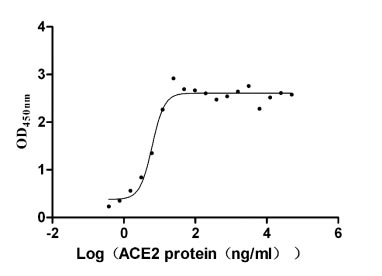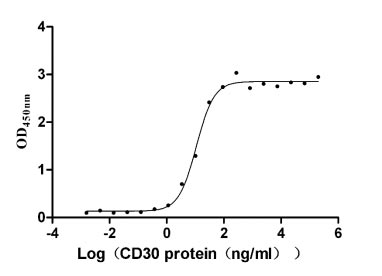Recombinant Human Quinone oxidoreductase PIG3 (TP53I3)
-
货号:CSB-YP687492HU
-
规格:
-
来源:Yeast
-
其他:
-
货号:CSB-EP687492HU
-
规格:
-
来源:E.coli
-
其他:
-
货号:CSB-EP687492HU-B
-
规格:
-
来源:E.coli
-
共轭:Avi-tag Biotinylated
E. coli biotin ligase (BirA) is highly specific in covalently attaching biotin to the 15 amino acid AviTag peptide. This recombinant protein was biotinylated in vivo by AviTag-BirA technology, which method is BriA catalyzes amide linkage between the biotin and the specific lysine of the AviTag.
-
其他:
-
货号:CSB-BP687492HU
-
规格:
-
来源:Baculovirus
-
其他:
-
货号:CSB-MP687492HU
-
规格:
-
来源:Mammalian cell
-
其他:
产品详情
-
纯度:>85% (SDS-PAGE)
-
基因名:
-
Uniprot No.:
-
别名:p53 induced gene 3 protein ; p53-induced gene 3 protein; Putative quinone oxidoreductase; QORX_HUMAN; quinone oxidoreductase homolog; Quinone oxidoreductase PIG3; TP53I3; Tumor protein p53 inducible protein 3; Tumor protein p53-inducible protein 3
-
种属:Homo sapiens (Human)
-
蛋白长度:full length protein
-
表达区域:1-332
-
氨基酸序列MLAVHFDKPG GPENLYVKEV AKPSPGEGEV LLKVAASALN RADLMQRQGQ YDPPPGASNI LGLEASGHVA ELGPGCQGHW KIGDTAMALL PGGGQAQYVT VPEGLLMPIP EGLTLTQAAA IPEAWLTAFQ LLHLVGNVQA GDYVLIHAGL SGVGTAAIQL TRMAGAIPLV TAGSQKKLQM AEKLGAAAGF NYKKEDFSEA TLKFTKGAGV NLILDCIGGS YWEKNVNCLA LDGRWVLYGL MGGGDINGPL FSKLLFKRGS LITSLLRSRD NKYKQMLVNA FTEQILPHFS TEGPQRLLPV LDRIYPVTEI QEAHKYMEAN KNIGKIVLEL PQ
-
蛋白标签:Tag type will be determined during the manufacturing process.
The tag type will be determined during production process. If you have specified tag type, please tell us and we will develop the specified tag preferentially. -
产品提供形式:Lyophilized powder
Note: We will preferentially ship the format that we have in stock, however, if you have any special requirement for the format, please remark your requirement when placing the order, we will prepare according to your demand. -
复溶:We recommend that this vial be briefly centrifuged prior to opening to bring the contents to the bottom. Please reconstitute protein in deionized sterile water to a concentration of 0.1-1.0 mg/mL.We recommend to add 5-50% of glycerol (final concentration) and aliquot for long-term storage at -20℃/-80℃. Our default final concentration of glycerol is 50%. Customers could use it as reference.
-
储存条件:Store at -20°C/-80°C upon receipt, aliquoting is necessary for mutiple use. Avoid repeated freeze-thaw cycles.
-
保质期:The shelf life is related to many factors, storage state, buffer ingredients, storage temperature and the stability of the protein itself.
Generally, the shelf life of liquid form is 6 months at -20°C/-80°C. The shelf life of lyophilized form is 12 months at -20°C/-80°C. -
货期:Delivery time may differ from different purchasing way or location, please kindly consult your local distributors for specific delivery time.Note: All of our proteins are default shipped with normal blue ice packs, if you request to ship with dry ice, please communicate with us in advance and extra fees will be charged.
-
注意事项:Repeated freezing and thawing is not recommended. Store working aliquots at 4°C for up to one week.
-
Datasheet :Please contact us to get it.
相关产品
靶点详情
-
功能:May be involved in the generation of reactive oxygen species (ROS). Has low NADPH-dependent beta-naphthoquinone reductase activity, with a preference for 1,2-beta-naphthoquinone over 1,4-beta-naphthoquinone. Has low NADPH-dependent diamine reductase activity (in vitro).
-
基因功能参考文献:
- Results revealed that PIG3 expression levels positively correlated with poor prognosis of non-small cell lung cancer (NSCLC) patients and indicate that PIG3 promotes NSCLC progression. PMID: 28259183
- Data suggest that PIG3 was involved in HIF-1alpha regulation, and indicate a signaling pathway of PIG3/HIF-1alpha in the regulation of cell migration in renal cell carcinoma. PMID: 27029070
- our data suggest that high expression of p53-inducible gene 3 is significant for glioblastoma inhibition and p53-inducible gene 3 independently indicates good prognosis in patients, which might be a novel prognostic biomarker or potential therapeutic target in glioblastoma. PMID: 28351326
- Data indicate that knockdown of p53-induced gene 3 (PIG-3) expression by small interfering RNA (siRNA) treatment can inhibit the generation of reactive oxygen species (ROS). PMID: 26472723
- The results suggested that PIG3 plays an oncogenic role in PTC via the regulation of the PI3K/AKT/PTEN pathway and support the exploration of PIG3 as a novel biomarker for patients with papillary thyroid carcinoma PMID: 26133772
- PIG3, which functions in DNA damage repair, uses an unexpected catalytic mechanism to suppress Rho-ROCK activity and impair tumor invasion in vivo. This regulation was suppressed by antioxidants. PMID: 26464464
- prohibitin and prohibiton (PHB2) contribute to PIG3-mediated apoptosis by binding to the PIG3 promoter (TGYCC)15 motif PMID: 24388982
- study provides evidence that the variant genotypes of (TGYCC)n repeats in the PIG3 promoter are functional and associated with risk of squamous cell carcinoma of the head and neck in a non-Hispanic white population PMID: 23241165
- a novel signaling pathway of GPx3-PIG3 in the regulation of cell death in prostate cancer. PMID: 22461624
- certain p53 mutatants activate PIG3, whereas the result of our study show increased full-length transcript expression in tumor counterparts PMID: 20603616
- Results suggest that PIG3 is a critical component of the DNA damage response pathway and has a direct role in the transmission of the DNA damage signal from damaged DNA to the intra-S and G2/M checkpoint machinery. PMID: 20023697
- p53 activity and PIG3 gene function are uncoupled by UV-dependent alternative splicing through rapid proteolytic degradation PMID: 15067011
- suppression of p53-C277Y by RNAi reduced pig3 promoter activity, RNA, and protein expression PMID: 15192123
- numerous factors contribute to the normal alternative splicing of PIG3 exon 4 and UV-inducible increases in this process require that the splicing of this exon be maintained in a sufficiently weakened state under normal conditi PMID: 18801469
- PIG3 action is through oxidative stress produced by its enzymatic activity and provides essential knowledge for eventual control of apoptosis. PMID: 19349281
收起更多
-
蛋白家族:Zinc-containing alcohol dehydrogenase family, Quinone oxidoreductase subfamily
-
数据库链接:
HGNC: 19373
OMIM: 605171
KEGG: hsa:9540
STRING: 9606.ENSP00000238721
UniGene: Hs.50649





-AC1.jpg)


-AC1.jpg)
-AC1.jpg)










